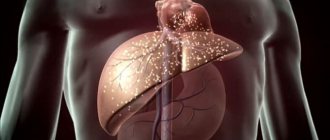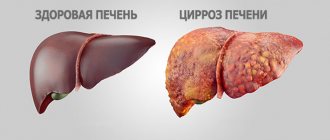The article was checked by gastroenterologist E.G. Melnikova. , is for general informational purposes only and does not replace specialist advice. For recommendations on diagnosis and treatment, consultation with a doctor is necessary.
At the Clinical Hospital on Yauza, expert diagnostics of liver cirrhosis is carried out (the whole range of laboratory tests, CT, MRI, ultrasound, fibroelastography, endoscopy, biopsy, etc.), allowing one to determine its severity, causes, as well as conservative treatment of liver cirrhosis by experienced gastroenterologists - hepatologists ( modern pharmacotherapy, methods of extracorporeal hemocorrection - EG). In most cases, we achieve a controlled, compensated course of the disease and an improvement in the patient’s well-being.
About the disease
The liver is one of the most important organs of the human body, ensuring the purification of toxins from the blood. The organ also takes an active part in digestion, carbohydrate, lipid and protein metabolism. It is not surprising that any malfunction of the liver negatively affects the entire body and the patient’s quality of life.
Liver cirrhosis is a serious disease, as a result of which liver tissue is replaced by connective tissue and the organ ceases to perform its function. Cirrhosis is a chronic, progressive disease that can lead to very serious, life-threatening consequences.
Sign up for a consultation
Prognosis for liver cirrhosis
Until recently, the disease was considered fatal, and most patients died within a few years of diagnosis from liver cancer, which develops in about 5% of cases, liver failure leading to coma, bleeding from the dilated veins of the esophagus and other consequences of cirrhosis.
Fortunately, medicine does not stand still, and today, with timely diagnosis and immediate treatment, the prognosis is much more favorable: many patients who have been treated for liver cirrhosis live and thrive for many years.
Timely contact with specialists increases the chances of successful treatment and prolongation of life. Such patients require constant medical monitoring and supportive therapy for cirrhosis, aimed at compensating for liver failure.
That is why, if you have the slightest suspicion of this disease or the threat of its development, you must immediately contact a specialist.
Forecast. Prevention
The prognosis of the disease largely depends on the causes of cirrhosis, the speed of making the final diagnosis, the severity of the disease, the available life reserves (the presence of chronic concomitant diseases) and timely medical care.
According to statistics, the ten-year survival rate ranges from 35% to 67%. It is predicted that with a “C” severity class (more than 10 points on the Child-Pugh scale), the probability of death within one year is 50%.
The Model for End-Stage Liver Disease (MELD) is used to estimate life expectancy when planning liver transplantation.
Three-month statistical forecast for MELD:
- less than 9 points—mortality rate 2.9%;
- 10-19 points - 7.7%;
- 20-29 points - 23.5%;
- 30-39 points - 60%;
- more than 40 points - 81%.
After liver transplantation, the five-year survival rate is 80%.
To prevent the development of the disease and the formation of complications in patients with cirrhosis, they begin with secondary prevention measures:
- preventive vaccinations against hepatitis B, since, according to some sources, hepatitis B infection of a patient with cirrhosis of a non-viral cause leads to death in 50-60% of cases after the development of acute viral hepatitis;
- complete exclusion of alcohol and hepatotoxic drugs.
To reduce the risk of complications, diuretics, beta-blockers, hypoammonemic therapy and venotonic drugs (Detrolex and Phlebodia) are used. They correct the concentration of proteins and albumin in the blood, improve blood clotting and stop bleeding from varicose veins of the esophagus.
Additionally, osteoporosis and thrombosis are prevented, especially with long-term use of glucocorticosteroids. For this purpose, calcium and zinc preparations, vitamin D, bisphosphonates are used, symptomatic treatment of itching, control and treatment of anemia are carried out.
Prevention of the development of the disease involves:
- timely seeking medical help;
- the need for a salt-free diet;
- control of fluid balance (measurement of body weight, abdominal volume and daily diuresis, taking into account fluid intake);
- control of self-awareness (handwriting test and physical therapy to combat physical inactivity).
Prevention of infectious complications is carried out through vaccination and timely administration of antimicrobial drugs.[4][6][7]
Symptoms of liver cirrhosis
Unfortunately, cirrhosis of the liver does not manifest itself for a long time. The liver has great compensatory capabilities, so the disease can be asymptomatic for a long time or with minimal manifestations. The appearance of pronounced clinical symptoms indicates significant liver damage.
What symptoms should alert the patient? The appearance of dull, aching pain in the right hypochondrium, which may be accompanied by an increase in the volume of the abdomen and a feeling of bitterness in the mouth.
As the disease progresses, these symptoms are added:
- weakness and fatigue;
- sleep disorders – drowsiness, insomnia;
- low mood, irritability;
- causeless bleeding from the nose and gums;
- loss of appetite;
- weight loss;
- frequent nausea;
- increased gas formation;
- the appearance of skin itching, scratching, “spider veins” on the body;
- yellowing of the skin and sclera;
- redness of the palms (“liver palms”);
- enlargement of the mammary glands in men.
If these symptoms are detected, we invite you to undergo examination at our hospital. Please note that the liver has a large margin of safety, so symptoms may appear and disappear. In any case, do not delay visiting a specialist.
As the disease progresses, it leads to the development of jaundice, ascites (fluid accumulation in the abdominal cavity), peripheral edema, and hemorrhagic diathesis.
Without qualified help, in 100% of cases with cirrhosis, the patient will die. Early diagnosis and well-chosen treatment make it possible to control the disease for many years. Sign up for an examination and consultation with a specialist to get accurate information about your health.
Sign up for a consultation
Symptoms of common forms of CPU
In the case of the development of highly active cirrhosis of the liver, bloating and pain in the right hypochondrium are noted.
When examining patients with common forms of cirrhosis, the following is revealed:
- yellowness of the sclera;
- darkening of the skin color on the neck to gray-brown;
- dilation of the veins in the abdominal wall, resembling the head of a jellyfish;
- when listening to the epigastric region, the presence of venous noise;
- shortening of the tendons of the palms.
In 50-80% of patients, dilatation of small vessels (telangiectasia) is observed. On palpation, there is a distinct thickening of the liver, which has an uneven lower edge. It is possible that the organ will decrease in volume.
An enlargement of the spleen is also noted - its edge protrudes from under the ribs by 1-3 cm. Common forms of liver cirrhosis are accompanied by a clinical picture of protein-energy deficiency, edema and liver odor.
Symptoms in low-active and initial stages of cirrhosis
Most often there is an asymptomatic course. Cirrhosis is detected during a medical examination or clinical examination, or in the case of an examination due to a related disease with extrahepatic manifestations.
Inactive cirrhosis does not have liver-related complaints. Patients complain of a seasonal decrease in performance, frequent colds, dark urine and bleeding gums. Patients note a deterioration in tolerance to neuropsychic and prolonged physical activity.
There is no jaundice. An increase in bilirubin is observed only in the acute stage of hepatitis. Mild skin telangiectasia is present. Spider veins appear in the chest area in 40-60% of cases. The liver is dense, the spleen is enlarged.
Causes of cirrhosis
In 100% of cases, the formation of cirrhosis is preceded by hepatitis, which can be asymptomatic for years or even decades. Long-term hepatitis leads to the formation of fibrosis (replacement of liver cells with connective tissue). At a certain point, the destruction becomes irreversible and the organ stops working.
The most common cause of this disease is hepatitis, caused by the following factors:
- taking drugs and toxic medications;
- viral hepatitis;
- diabetes mellitus and some other diseases;
- metabolic disorders;
- violation of the outflow of bile;
- storage diseases;
- autoimmune processes, etc.
The most common cause of liver cirrhosis is alcohol abuse. Anything that damages the liver can lead to cirrhosis.
Other causes include hereditary diseases: alpha-1 antitrypsin deficiency (accumulation of an abnormal protein in the liver), hemochromatosis (excess iron), Wilson's disease (excess copper), cystic fibrosis (sticky, thick mucus in the liver). Also worth highlighting are diseases associated with glycogen storage (the liver cannot store or break down glycogen, a form of sugar) and primary sclerosing cholangitis (inflammation of the bile ducts leads to scarring and narrowing of the ducts and accumulation of bile in the liver).
Changes caused by liver diseases that lead to cirrhosis occur gradually. Liver cells become damaged, and if the damage continues, the cells begin to “die.” Over time, scar tissue replaces the damaged structures and the liver cannot function properly.
Etiology
As liver function deteriorates, other, more common symptoms of cirrhosis appear, including:
- minor bruises and bleeding;
- swelling of the lower extremities;
- accumulation of fluid in the abdomen/abdomen (ascites);
- brown or orange urine;
- light color of stool;
- confusion, difficulty thinking, memory loss, personality changes;
- redness of the palms of the hands;
- men experience loss of sexual desire;
- Women experience premature menopause.
Cirrhosis of the liver becomes painful as it worsens. Up to 82% of patients in whom the diagnosis was confirmed report the presence of pain.
Most patients report abdominal pain. In the liver area, you may feel a dull, throbbing pain or tingling sensation in the right upper abdomen under the ribs. Discomfort may be due to swelling due to fluid retention. The cause may be an enlargement of the spleen and liver.
Routes of infection
It is impossible to become infected with CPU. But if the cause of the disease is viral hepatitis, then its pathogen is transmitted through blood, from mother to child and through unprotected sexual intercourse.
Features of liver cirrhosis in children
CP in childhood is extremely rare. It's connected with:
- cardiogenic disorders (heart failure and pulmonary hypertension);
- autoimmune liver damage;
- congenital storage diseases (congenital form of hemochromatosis);
- phleboportal cirrhosis (Banti).
Such children will have a poor prognosis. The most common outcome is death. In this case, many concomitant pathologies arise. An effective treatment method is liver transplantation.
Other changes
The fact is that cirrhosis causes the hemorrhoidal veins to dilate, so the stool may contain blood, which is explained by the presence of hemorrhoids. As a rule, there is little blood, it is scarlet in color and appears only during bowel movements.
Stool color scale
A warning sign is black stool called melena. As a rule, the stool is liquid and unformed. This indicates internal bleeding caused by varicose veins, which is characteristic of cirrhosis. In addition to black stool, vomit the color of coffee grounds often appears. In this case, it is necessary to call an ambulance to provide urgent assistance to the patient.
Thus, we can identify several more reasons for changes in the color of feces during cirrhosis:
- Complications of diseases affecting the gastrointestinal tract.
- Internal bleeding.
- Haemorrhoids.
- Varicose veins of various locations.
Stages of liver cirrhosis
CPU has no stages. If you have been diagnosed with cirrhosis, you are beyond the early stages of liver disease. Having cirrhosis means that your liver has scar tissue because it has been damaged.
Only stages of development of liver fibrosis can be distinguished:
- F1 – moderate proliferation of connective tissue, no symptoms.
- F2 – fibrosis that occurs without pronounced manifestations.
- F3 – pronounced proliferation of connective tissue leads to a decrease in liver function; bloating, psychosomatic disorders, stool disorders and weakness are noted.
- F4 – only at this stage can we talk about the development of liver cirrhosis.
Diagnostics at the clinical hospital on Yauza
Diagnosis of cirrhosis includes a whole range of measures and begins with a survey and examination of the patient by an experienced gastroenterologist-hepatologist. Having suspected a patient of cirrhosis, our doctors send him for additional examination.
Laboratory diagnostics
The range of available laboratory tests includes all the necessary tests:
- general clinical blood and urine tests;
- a detailed biochemical blood test, especially important in diagnosing the functional state of the liver;
- serological studies and PCR diagnostics for viral hepatitis;
- blood clotting test;
- markers of thesaurismosis (storage diseases);
- markers of autoimmune liver diseases.
Additional tests are also prescribed to exclude concomitant pathologies of other organs and systems.
Instrumental examination
Ultrasound examination – ultrasound of the abdominal organs with triplex scanning of the vessels of the portal system at an expert level. Allows you to draw up a detailed picture of the state of the hepato-biliary system and other abdominal organs, assess portal blood flow, and identify signs of portal hypertension.
If necessary, the examination can be supplemented with:
- computed tomography (CT scan of the abdominal cavity);
- magnetic resonance imaging (MRI of the abdominal organs, MRI of the liver and pancreas, MR cholangiopancreatography);
- expert gastroscopy (FGDS);
- Endoultrasound is an endoscopic ultrasound examination that can detect formations of 1 mm in size in the upper parts of the digestive tract, including in the gallbladder and ducts, liver;
- fibroelastography – assessment of the severity of liver fibrosis;
- It is possible to perform a puncture biopsy.
The expert level of diagnosis of liver cirrhosis, its causes and severity is ensured by the high qualifications of our specialists and the advanced equipment of the Yauza Clinical Hospital, recognized as one of the best in Moscow. An in-depth examination allows you to accurately determine the stage of the disease and the nature of its course, and select treatment taking into account the individual characteristics of each individual patient.
Sign up for a consultation
In most cases, complications of the disease can be prevented if detected in the early stages. However, the disease is usually asymptomatic. Only regular preventive examinations can detect pathology in time. Sign up for an examination now to avoid problems in the future.
Differential diagnosis
It is carried out in the presence of non-cirrhotic causes of liver enlargement. The disease is differentiated from viral, drug and alcohol-type hepatitis. For this, immunology, PCR and hepatitis virus markers are used.
Differential diagnosis is necessary with:
- congenital pathologies (Wilson-Konovalov disease, hemochromatosis, alpha-1-antitrypsin deficiency);
- non-alcoholic fatty liver disease;
- metastases or malignant neoplasm of the liver;
- sclerosing cholangitis of the primary type;
- biliary cirrhosis (primary and secondary);
- autoimmune hepatitis;
- toxic effects of medications, heavy metals, etc.;
- narrowing of the bile ducts.
To make an accurate diagnosis, a consultation with a geneticist, cardiologist, ophthalmologist and psychiatrist is prescribed.
Diagnostics
Diagnosis of liver cirrhosis begins with a clinical examination, which includes collecting complaints and examination.
During examination, the doctor may detect external signs of CP1:
- Redness on the palms and soles (palmaral erythema)
- Spider veins
- Reduction of hair in the armpits
- White nails
- Men with cirrhosis of the liver may experience gynecomastia, an enlargement of the mammary glands. The reasons for this are considered to be a reduced level of testosterone and an increased level of estradiol (the female sex hormone) in the blood due to various mechanisms: increased processes of aromatization of testosterone into estradiol, as well as increased production of globulin that binds sex steroids, and thus a decrease in the level of free testosterone.6 .7
Later, edema may appear, especially in the lower extremities, jaundice, and the development of ascites - accumulation of free fluid in the abdominal cavity.
When palpating the abdomen, an enlarged liver is detected; it is often possible to palpate the nodal surface of the organ, the pointed edge. However, in the final stage of the disease, the size of the liver may decrease, and the spleen may increase.1 To confirm the diagnosis and establish the stage of the disease, laboratory and instrumental studies are carried out, and calculated indices are also used.
Laboratory methods
- Standard biochemical tests that determine the level of bilirubin, total protein, prothrombin index, serum iron, ferritin and enzyme activity (AST, ALT, alkaline phosphatase). These tests are nonspecific, their deviations can be observed in other diseases, but they help assess the degree of liver dysfunction.
- General clinical blood tests can reveal the presence of anemia, a decrease in the number of leukocytes, platelets, which can also be observed with cirrhosis.
- Tests for hepatitis viruses and other infectious agents may be ordered to determine the potential cause of the disease.
Calculation indices:
The use of test panels, such as FibroTest, FibroIndex, Hepascore, can be used to assess the stage of fibrosis. For example, the use of the Fibrotest score avoided biopsy in 50% of patients.2
To assess the severity of cirrhosis and predict survival, the Child-Pugh classification is most often used.2 The scale, which takes into account the results of laboratory tests and clinical manifestations, allows one to assess the degree of functional impairment and determine the stage of the disease. The higher the score, the worse the prognosis.2
Instrumental studies
In addition to needle biopsy, which is recognized as the “gold standard” for diagnosing fibrosis and cirrhosis, liver imaging methods play an important role in diagnosis. These include:
- Ultrasound of the liver, abdominal organs and retroperitoneal space. The most accessible and fairly informative method. Allows you to evaluate the anatomical and structural features, shape, size, vascular pattern. CP can be judged by an increase in the size of the liver and by its heterogeneous structure and uneven tuberous contour. Also, with liver cirrhosis, ultrasound may show signs of portal hypertension: ascites, dilation of portal veins, enlarged spleen.1
- CT, MRI (computer and magnetic resonance imaging of the liver) - by performing a large number of thin sections, it provides comprehensive information about the structure of the organ, the presence of fibrous nodes, false lobules, additional vessels, etc.
- Ultrasound elastometry (FibroScan device) can serve as an alternative to liver tissue biopsy, as it makes it possible to assess the density of the organ, which increases as the percentage of connective tissue increases.2
Only a comprehensive diagnosis can give a complete picture of the disease, so a combination of various methods is used, which sometimes have to be repeated several times.
Treatment of cirrhosis in the clinical hospital on Yauza
We offer an integrated approach to the treatment of cirrhosis. Our medical center employs experienced specialists and has modern expert-class equipment.
Etiopathogenetic treatment
When developing a treatment plan, our doctors, based on examination data, identify the cause of the development of hepatitis that led to cirrhosis, and try to eliminate or reduce its negative impact. If the cause is another disease, it must be treated. If the development of the disease is provoked by any harmful influence or improper lifestyle, they are also subject to correction.
Improving organ function
The second goal of treatment is to improve the metabolism of liver cells, achieve compensated stable functioning of the organ, and control the course of the disease.
Conservative treatment
The main type of treatment for cirrhosis is conservative therapy, including:
- Drug treatment (antiviral, immunosuppressive, detoxifying, diuretic drugs, drugs that reduce pressure in the portal vein system, laxatives, normalizing colon microflora and others, depending on the clinical situation). Drug treatment eliminates the etiological factor and prevents the development of complications of liver cirrhosis. Our doctors, when choosing treatment tactics, are based on the principles of evidence-based medicine and authoritative Western and Russian recommendations.
- Diet therapy. The diet should be high in protein and high in calories, but not in the case of severe hepatic encephalopathy. When fluid accumulates in the abdominal cavity, a low-salt diet is necessary, protein consumption is 1.5 g per 1 kg of weight.
- Complete abstinence from alcohol. Elimination of alcohol-containing drinks helps to improve the condition as quickly as possible.
- Limiting physical activity. Allows you to prevent the development of complications.
Conservative treatment is usually carried out on an outpatient basis. In this case, the patient is under dispensary observation and must regularly visit the doctor. If necessary, the patient can undergo a course of intravenous drip infusions in our comfortable hospital.
Contrary to popular belief, cirrhosis is not a disease of alcoholics and antisocial elements. In 60% of cases it affects completely respectable people. Don't rely on chance. Make an appointment with your doctor to check your health now.
When a cure is not possible
Even if in severe cases our specialists cannot cure cirrhosis, we have been caring for the patient for years. Supportive therapy provided by our doctors helps patients wait for a liver transplant with minimal risk of developing life-threatening complications (ascites, bleeding, liver failure, encephalopathy).
We do not treat cirrhosis separately, but treat the patient comprehensively!
Our patients have the entire arsenal of capabilities of a modern premium-class metropolitan hospital at their disposal. We can provide treatment not only for liver cirrhosis, but also for all concomitant medical and surgical pathologies - in 35 medical specializations.
Extracorporeal hemocorrection (EG)
If autoimmune hepatitis is identified as the cause of the development of liver cirrhosis, the patient is prescribed treatment using extracorporeal hemocorrection technologies, carried out in a special department of our hospital.
These methods (cryoapheresis, cascade plasma filtration, etc.) allow:
- reduce the level of autoantibodies in the blood and thereby stop the inflammation they provoke;
- increase the patient's sensitivity to pharmacotherapy;
- achieve a state of compensation more quickly and prolong it;
- minimize the risk of autoimmune damage to other organs and systems.
Treatment of complications of cirrhosis
If life-threatening complications develop (mainly bleeding from the dilated veins of the esophagus), emergency surgical intervention may be required. If conservative therapy is ineffective, the possibility of liver transplantation is considered.
Our hospital does not provide surgical treatment for liver cirrhosis, but our specialists use conservative treatment methods to help avoid urgent (life-threatening) conditions and wait for transplantation.
Nutrition and daily routine
With CP, stool control is necessary. Bowel movements should be performed 2 times a day. To normalize intestinal functions, it is recommended to take lactulose. Food should be taken 5 times a day in fractional portions.
Every morning you should:
- Measure body weight.
Record abdominal volume indicators at the level of the navel;
- Determine daily fluid balance (diuresis).
- Add up all liquid taken orally.
The overall goal is positive diuresis. The patient should excrete 200 ml more fluid when urinating. What did you drink?
Transplantation
For acute or chronic liver failure, your doctor may recommend a liver transplant. The transplant can be from a living or deceased donor. Only part of the donor liver needs to be transplanted. The liver is the only human organ that can grow back.
Information for patients on liver cirrhosis
M.N. Mayevskaya, Lapshin A.V.
Clinic of Propaedeutics of Internal Diseases, Gastroenterology and Hepatology named after. V.Kh. Vasilenko MMA named after. THEM. Sechenov. Director of the clinic V.T. Ivashkin.
Why do we need a liver?
The liver is the largest organ of the human body; it is located in the upper right quadrant of the abdomen and covered by the ribs. Its mass reaches 1500 g, which is approximately 1/50 of the mass of the entire body. Anatomically, the liver has two lobes - right and left. The right lobe is almost 6 times larger than the left.
The liver is a very important organ for life; it acts as a filter for the human body. Please note how many functions it performs:
- Synthesis of proteins, blood coagulation factors, hemoglobin, components of the immune system.
- Participation in the metabolism of fats, carbohydrates, water, vitamins.
- Participation in the functioning of the endocrine system (hormone processing).
- The production and secretion of bile, without which normal digestion is impossible.
- Accumulation and storage of useful compounds: glycogen (a substance that provides a supply of glucose in the body), fats, microelements.
- Neutralization of various compounds entering the body from the environment (including drugs)
What is cirrhosis of the liver?
Cirrhosis (cirrhosis: Greek: kirrhos lemon yellow), meaning orange or tan color. Due to the death of liver cells under the influence of various damaging factors, normal liver tissue is replaced by fibrous tissue with the formation of nodes and restructuring of the entire structure of the liver. Violation of the liver structure leads to disruption of all its functions.
Causes of liver cirrhosis
Most often, cirrhosis of the liver develops as a result of a long course of chronic viral hepatitis, which is caused by viruses B and C. The second very important reason for the development of cirrhosis is alcohol abuse. Unfortunately, often the cause of cirrhosis cannot be identified, in which case it is called cryptogenic (i.e. with an unknown cause).
Less commonly, cirrhosis is formed due to a violation of the outflow of bile, metabolic disorders of certain elements (copper, iron, etc.), as a result of heart failure, autoimmune disorders (when the body perceives its own cells as foreign).
How does liver cirrhosis manifest?
Signs of cirrhosis do not depend on what caused it, but are determined by the stage of the disease.
At the initial stage of cirrhosis (according to the international classification this is class A), there are still no complications of the disease.
It is at this time that it is very important to eliminate the cause of the disease, which will allow you to preserve the remaining healthy liver tissue and lead a normal lifestyle. The fact is that the liver has very great regeneration (restoration) capabilities, and healthy cells can work for themselves and their injured comrades.
The liver's ability to regenerate is described in the ancient Greek myth of Prometheus.
Every day an eagle flew in and pecked out his liver, and by morning it was restored again.
An increase in the volume of the abdomen, the appearance of changes in consciousness and behavior, bleeding gums, and nosebleeds indicate complications of the disease (according to the international classification, these are classes B and C).
Cirrhosis does not always progress; treatment can stop its further development.
What can a patient with liver cirrhosis complain about??
- Increased fatigue
- Weight loss
- Various disorders of consciousness and behavior (decreased concentration, daytime sleepiness, disturbance of night sleep, etc.)
- Decreased appetite and abdominal discomfort (bloating, feeling quickly full while eating)
- Jaundice (yellow coloration of the skin and sclera).
- Lightening or discoloration of stool, dark urine
- Stomach ache
- Swelling of the legs and (or) increase in the size of the abdomen due to free fluid in the abdominal cavity (ascites)
- Bleeding: nasal, gastrointestinal, gum, hemorrhoidal, and subcutaneous hemorrhage
- Frequent bacterial infections (respiratory tract, etc.)
- Decreased sex drive
- In men, gynecomastia (enlarged mammary glands) is common.
Complications of liver cirrhosis
A patient with liver cirrhosis and his relatives should be well aware of their disease, its complications and be able to provide first aid.
Hepatic encephalopathy
Hepatic encephalopathy is reversible damage to the brain from toxic products that are not neutralized by the liver as a result of its damage.
Hepatic encephalopathy is characterized by various disorders of consciousness, intelligence, behavior, and neuromuscular disorders.
Hepatic encephalopathy can be latent (unnoticeable to the patient and others), and then it can only be detected by a doctor when conducting special tests.
The extreme degree of hepatic encephalopathy is coma (unconscious state), it is based on acute or chronic liver failure.
What can lead to the development or worsening of hepatic encephalopathy?
- Uncontrolled use of diuretics, vomiting and diarrhea. Why? They are accompanied by the loss of large amounts of fluid and disturbances in the composition of blood electrolytes.
- Bleeding from varicose veins of the esophagus and stomach, ulcers of the stomach and/or duodenum, ruptures of the mucous membrane of the stomach and esophagus during vomiting. Why? When bleeding from the upper gastrointestinal tract, blood enters the intestinal lumen, where it is processed and absorbed. This leads to the formation of a large amount of toxic substances, in particular ammonia. Toxic substances are not completely neutralized by the liver and enter the brain. In addition, in such conditions the brain suffers from a lack of oxygen.
- Infections of the respiratory tract, urinary system, etc.
- Constipation (increased absorption of toxic substances in the intestines).
- Protein-rich foods. Why? Proteins are the main source of ammonia formation in the intestines. Ammonia is a major toxic product for the brain.
- Alcohol consumption (suppression of the central nervous system and additional damaging effects on the liver).
- Taking drugs that depress brain activity (sleeping pills, etc.)
Bleeding from the upper gastrointestinal tract
With cirrhosis of the liver, normal blood flow through the blood vessel is disrupted. This occurs due to disruption of the normal structure of the liver and the formation of nodes. The nodes compress the blood vessels and force the blood to make its way through bypass paths (anastomoses). As a result, blood pressure increases in those vessels that are not suitable for this. For example, veins along the esophagus and in the upper third of the stomach, veins around the navel and rectum. A constant increase in pressure in these vessels leads to their varicose expansion and the threat of bleeding.
What can cause gastrointestinal bleeding?
Bleeding can begin with a sharp rise in pressure in the abdominal cavity, so patients with varicose veins of the esophagus and stomach are not recommended to lift weights or do abdominal exercises. Ascites (fluid in the abdomen) and vomiting also increases the risk of developing this form of bleeding.
If gastrointestinal bleeding is suspected:
- Keep calm
- Put the cold on your stomach
- Get into bed
- Call an ambulance
- Ask your relatives to notify your doctor.
Every patient with cirrhosis of the liver should know that gastrointestinal bleeding is manifested by vomit that looks like “coffee grounds” and loose stools that look like “raspberry jelly”; weakness appears or sharply increases until loss of consciousness.
Infectious complications of liver cirrhosis
Patients with liver cirrhosis are more susceptible to bacterial and viral infections than healthy people. Most often, such patients experience infections of the respiratory tract and urinary system. Sometimes it happens that the body temperature can rise without a specific reason. This is due to the increased absorption of “harmful” (toxic) microorganisms in their intestines. This condition is called endotoxemia.
How to behave at home
General tips:
- Rest as soon as you feel tired.
- Don't lift heavy objects. A sharp rise in pressure in the abdominal cavity can provoke gastrointestinal bleeding.
- Bowel control is extremely important in patients with cirrhosis. The optimal stool frequency is 2 times a day.
Patients with liver cirrhosis are recommended to take lactulose to normalize intestinal function and the composition of the intestinal flora in favor of “good” bacteria.
To improve digestion, patients with liver cirrhosis are prescribed multienzyme drugs. Your attending physician will help you choose the optimal drug.
If there is fluid retention in the body (edema, ascites), it is necessary to limit the intake of table salt to 0.5 g per day, liquid intake to 1000 - 1500 ml per day.
Every morning you need:
- measure body weight, abdominal volume at the level of the navel (an increase in abdominal volume and body weight indicates increasing fluid retention);
- count the fluid balance per day (diuresis): sum up all the liquid taken orally (tea, skin, water, soup, fruit, etc.), sum up all the liquid released during urination. Our common goal is positive diuresis, i.e. a patient with edema or ascites should excrete approximately 200 ml more per day than ingested: the amount of fluid excreted in the urine per day - the amount of fluid taken orally per day = 200 - 300 ml. Do not forget that large loss of fluid in the urine can provoke encephalopathy.
Agree on the dose of diuretics with your doctor. If you are passing too much urine, notify your doctor immediately.
To monitor the level of consciousness (degree of encephalopathy), we recommend using a simple handwriting test. Keep a diary in which you write a short phrase every day. Show your diary to your relatives. As soon as your handwriting changes, contact your doctor. Show your diary to your loved ones every day!
Basic Dietary Recommendations
For most patients with liver cirrhosis, 80-100 g of protein and 2500 kcal per day are sufficient. Food should be prepared in such a way that it stimulates the appetite. It is advisable to avoid drinking mineral waters containing sodium.
In patients with chronic hepatic encephalopathy, the protein content in food is limited to approximately 50 g per day, with preference given to plant proteins.
Alcohol is absolutely contraindicated for patients with liver cirrhosis!!!
- Food must be prepared without adding salt. There should be no salt on the table!
- Salt-free bread, crackers, cookies and crispbreads, as well as salt-free butter are consumed.
- Seasonings such as lemon juice, orange zest, onion, garlic, salt-free ketchup and mayonnaise, pepper, mustard, sage, cumin, parsley, marjoram, bay leaves, cloves and yeast extract (low salt) help enhance the enjoyment of dishes. to taste.
- Any products containing baking powder and baking soda (cakes, biscuits, cakes, pastries and regular bread) are excluded.
- Excluded are pickles, olives, ham, bacon, corned beef, tongues, oysters, mussels, smoked herring, canned fish and meat, fish and meat pate, sausage, mayonnaise, various jarred sauces and all types of cheeses, as well as ice cream.
- Salty canned foods are excluded.
- Allowed is 100 g of beef or poultry, rabbit or fish and one egg per day. One egg can replace 50 g of meat.
- Milk is limited to 1 glass per day. You can eat low-fat sour cream.
- You can eat boiled rice (without salt).
- Any vegetables and fruits are allowed, fresh or in the form of dishes prepared at home.
Approximate daily ration for a salt-free diet
Energy value 2000 - 2200 kcal.
Protein content up to 70 g.
Table salt content 380 -450 mg per day
Breakfast
Semolina porridge with cream and sugar or baked fruit. 60 g of salt-free bread, or crispbread, or salt-free crackers with unsalted butter and marmalade (jelly or honey). 1 egg. Tea or coffee with milk.
Dinner
60 g beef or poultry or 90 g white fish. Potato. Greens or lettuce. Fruits (fresh or baked).
Afternoon snack
60 g salt-free bread or crispbread. Unsalted butter, jam or tomato. Tea or coffee with milk.
Dinner
Soup without salt or grapefruit. Beef, poultry or fish (as for lunch). Potato. Greens or lettuce. Fruit (fresh or baked) or jelly made from fruit juice and gelatin. Sour cream. Tea or coffee with milk
Conclusion
Liver cirrhosis is not a fatal disease; it needs and can be effectively treated.
The treatment results are both disappointing and encouraging. The impaired architecture of the liver in liver cirrhosis is never restored. But liver cells retain such a significant ability to regenerate that even with cirrhosis of the liver, compensation of its function can be achieved.
If possible, the cause of the disease is eliminated, for example, in case of alcoholic cirrhosis of the liver, alcohol is excluded; in case of viral cirrhosis, antiviral treatment is prescribed.
Only a doctor can choose the optimal treatment regimen for a particular patient.
It has been proven that alcohol contributes to the decompensation of liver cirrhosis and its progression, so drinking alcohol in any form or quantity is prohibited.
If conservative (drug) treatment is ineffective, patients are included on the waiting list for a liver transplant.
Success in treating a patient with liver cirrhosis can only be achieved if the doctor’s advice is strictly followed.
The patient's behavior at home determines the course of the disease.
Does the course of liver cirrhosis depend on the gender of the patient?
Men are more likely to suffer from cirrhosis of the liver due to the higher prevalence of alcoholism. The majority of patients are men aged 30 to 60 years. Women more often develop autoimmune and hepatobiliary hepatitis, which threatens to transform into cirrhosis.
Treatment of liver cirrhosis in men is no different from treatment of liver cirrhosis in women. Therapy is determined not by gender, but by the clinical picture and form of the disease, as well as the characteristics of a particular patient and his concomitant pathology.
Liver cirrhosis, the symptoms and treatment of which were described above, is a chronic disease that requires constant monitoring and adequate treatment. Practicing an individual approach to each patient, specialists at the Yauza Clinical Hospital are ready to offer patients comprehensive care, including both treatment of the underlying disease and prevention of serious complications.
You can see prices for services in the price list or check by calling the phone number listed on the website.
How to return normal stool color?
In case of liver cirrhosis, no matter what stage of development the disease is at, it is necessary to strictly follow a number of rules:
- rest more often;
- avoid crowded places, do not contact sick people;
- do not lift heavy objects;
- take diuretics (the dosage is calculated by the attending physician);
- follow a diet;
- take medications prescribed by your doctor.
To restore intestinal function and maintain the balance of intestinal microflora, you should take Duphalac. This drug is a synthetic sugar that provides nutrition for beneficial bacteria. Duphalac helps normalize stool up to 2 times a day, has no side effects and is suitable for newborns.
Success in the treatment of liver cirrhosis depends on the stage of the disease and on compliance with all doctor’s recommendations. In advanced cases, the patient requires transplantation of the affected organ.
Complications of liver cirrhosis
There are many complications of CP. Because the disease develops over many years, some of these may be the first noticeable signs and symptoms of the disease.
Portal hypertension is the most common serious complication. This is an increase in pressure in the portal vein (a large blood vessel that carries blood from the digestive organs to the liver). This pathology is caused by blockage of blood flow in the liver as a result of cirrhosis. When blood flow through the veins is partially blocked, veins in the esophagus, stomach, or intestines may become enlarged (a condition called varicose veins). As pressure builds, they may bleed or even burst, causing internal bleeding.
Additional complications include:
Confusion, difficulty thinking, changes in behavior, even coma. This occurs when toxins from the intestines are not cleared by the damaged liver, circulate in the bloodstream, and accumulate in the brain (a condition called hepatic encephalopathy). Most people who develop liver cancer have cirrhosis.
Stool color as a sign of illness
One of the symptoms of the disease is a change in the color of feces, which is also typical for other liver pathologies.
What color is stool in liver cirrhosis? It brightens and may gradually become almost white. In medicine it is called acholic or discolored.
There are four stages in the course of the disease:
- Compensated.
- Subcompensated.
- Decompensated.
- Terminal.
Color change occurs at stages 2 and 3 of the disease. Discoloration of feces is a characteristic sign of liver failure, while urine, on the contrary, becomes dark. Such symptoms indicate cirrhosis or hepatitis.
With cirrhosis, stool takes on the color of white clay.
Prognosis and prevention
The damage already done to the liver is permanent. But the liver is a large organ. If part of it is still working, it may be possible to slow the progression of the disease, depending on its cause. For example, if CP is caused by alcohol abuse, you should stop drinking immediately. If you are obese or diabetic, you may need to lose weight and control your blood sugar to reduce damage to the liver.
Life expectancy depends on several factors, including the cause and severity of CP, response to treatment, presence of complications, age, and any other existing general health problems. If the disease progresses, liver transplantation may be an option.
You can reduce your risk of developing liver cirrhosis by taking care of your health. To do this, you need to adhere to the basic preventive recommendations:
- Do not drink alcohol if you have liver disease. It is easier to prevent cirrhosis than to take measures to improve the condition of the liver throughout the rest of your life.
- Eat a healthy diet. Add a lot of fruits and vegetables to the menu. Include whole grains and lean sources of protein in your diet. Reduce the amount of fatty and fried foods. Maintain a healthy weight. Excessive body fat can damage the liver.
- Reduce the risk of developing hepatitis. Sharing needles and having unprotected sex may increase your risk of developing hepatitis B and C. Ask your doctor about hepatitis vaccination.
If you have symptoms of liver dysfunction, consult our doctors and make an appointment.
FAQ
How to deal with insomnia with liver cirrhosis?
Proper rest is an integral part of successful treatment. You need to sleep at least 8 hours a day. The cause of insomnia in CP is stress. Experiences and imbalances in the level of melatonin and cortisol in the body. To overcome insomnia, it is recommended to go to bed at the same time every day. You should also not forget about outdoor walks and physical activity during the daytime.
You can see prices for services
Why do changes occur in stool during cirrhosis?
To confirm or refute suspicion of liver cirrhosis, it is necessary to undergo a general stool test. It will help identify the disease at the macroscopic, microscopic and chemical levels.
Changes in feces in liver cirrhosis are caused by pathological changes. Stool changes color because the body fails in the enzyme that turns stool the normal brown color.
If the liver works smoothly, then hemoglobin is converted into biliverdin. Biliverdin, in turn, is converted into bilirubin. It enters the intestine through the bile ducts, where it is converted into urobilin. This enzyme, passing through the kidneys, colors the urine in its natural color. In the intestines, urobilin is converted to stercobilin, which in turn gives feces a normal color.
This is interesting: Classification of liver cirrhosis according to Child Pugh: disease severity classes A, B and C
With cirrhosis, everything happens differently: the number of hepatocytes decreases, they are destroyed. Most of the bilirubin remains in the bloodstream and does not enter the intestines. Accordingly, the production of stercobilin does not occur, which makes it impossible for the stool to turn into its usual color.










